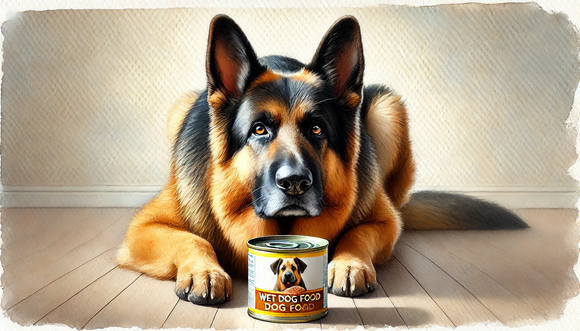Basics: Everything you need to know about wet food for dogs

What is wet food?
Wet food, also known as moist food, is a type of dog food that has a high moisture content, typically between 70% and 85%. It comes in cans, bowls or pouches and is available in different flavors and formulations. Unlike dry food, which comes in the form of kibble or pellets, wet food has a softer, paste-like consistency.
The production of wet food
The production of wet food begins with the selection of ingredients, which include meat, vegetables, grains and sometimes fruit. These ingredients are cooked and then filled into the packaging. The sealed containers are then heated to kill germs and preserve the food. This process often preserves wet food without the addition of artificial preservatives.
Advantages of wet food
High moisture content
A major advantage of wet food is its high water content. This can be particularly useful for dogs that don't drink much. It helps to keep your dog hydrated, which is important for kidney and urinary tract health.
Taste and texture
Many dogs find wet food tastier than dry food. The softer texture can be particularly beneficial for older dogs with dental problems or puppies who are still learning to chew solid food.
Less fillers
Wet food often contains fewer fillers such as wheat, corn or soy, which are found in many dry food mixes. This means that it usually contains more of the main ingredients such as meat and vegetables.
Disadvantages of wet food
Higher cost
Wet food is usually more expensive than dry food. As it contains more moisture, the actual content of nutrients per unit weight is also lower than with dry food.
Storage and shelf life
Once opened, wet food must be stored in the refrigerator and consumed within a few days to avoid spoilage. This can be more inconvenient compared to dry food, which can simply be stored in a sealed container.
Dental problems
While the softer texture of wet food can be helpful for dogs with dental problems, the lack of abrasion during chewing can contribute to tartar buildup and other dental diseases. It's important to monitor your dog's dental hygiene and support it if necessary.
How do you choose the right wet food?
Ingredients
Pay attention to the ingredients list. The first ingredients listed should be high-quality protein sources such as chicken, beef or fish. Avoid products with lots of artificial additives, fillers or unidentified meat meals.
Declaration
A good wet food has a clear declaration of ingredients and nutritional information. Look out for statements such as "complete food", which means that the food contains all the nutrients your dog needs on a daily basis.
Special needs
Consider your dog's special needs, such as allergies, intolerances or special life phases (puppy, senior, active dogs). There are special formulations for different needs that are tailored to your dog's specific requirements.
Wet food can be an excellent choice for your dog's diet, especially if they are fussy or have special dietary requirements. It offers many benefits, including high moisture content and tasty recipes. However, there are also disadvantages such as higher cost and shorter shelf life. Ultimately, it's important to consider your dog's needs and choose a high-quality product that supports their health and well-being.
More articles for you
Contact form problem fixed
Unfortunately, our contact form has not worked as desired in recent weeks. 😔 Due to an error in the spam detection, normal messages were also incorrectly filtered out.Read moreDangerous encounter: What you should do if your dog is bitten by a snake
It's every dog owner's nightmare: you're out in nature with your four-legged friend, he's sniffing the ground curiously, and suddenly you hear a hissing sound. Before you know it, your dog flinches and you recognize the signs of a snake bite. But don't panic! In this article, you will learn how to…Read moreWhat you should know about cherries for dogs
You may have heard that cherries are good for your health. They contain lots of vitamins, antioxidants and fiber, which can strengthen the immune system and aid digestion. But are cherries also suitable for dogs? And if so, how much and in what form should you offer them to your four-legged friend?…Read more


